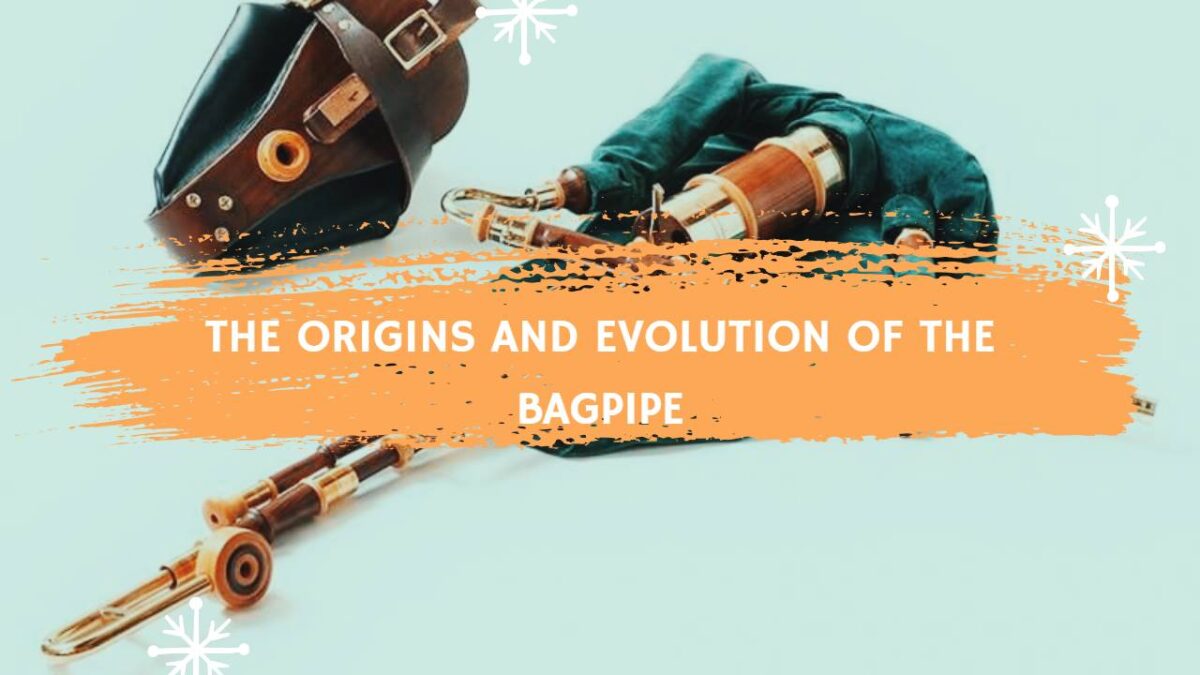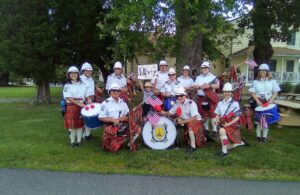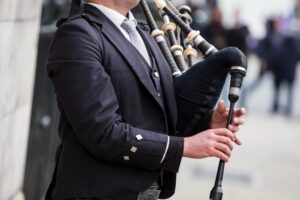The bagpipe is an instrument steeped in history and cultural significance, known for its unique sound and presence in various ceremonies and traditions around the world. This comprehensive post will explore the bagpipe’s origins, its evolution over the centuries, and its enduring global influence.
The Origins And Evolution Of The Bagpipe
Ancient Beginnings
Origins in Antiquity
The precise origins of the bagpipe are difficult to pinpoint due to the scarcity of early records, but archaeological and literary evidence suggests that the instrument was used in several ancient civilizations.
- Ancient Egypt: The oldest potential references to bagpipes come from ancient Egypt. Depictions from around 400 BC show instruments that resemble a bagpipe. Scholars like Emanuel Winternitz have noted similarities between ancient Egyptian reed instruments and the bagpipe’s chanter.
- Greece and Rome: In ancient Greece, the “aulos” was a double-piped wind instrument that some believe influenced the development of the bagpipe. Roman writers, including Suetonius and Dio Chrysostom, mentioned the “tibia utricularis,” a bagpipe-like instrument, suggesting its use in Roman times.
Early Construction
The early bagpipes were likely constructed from readily available materials, such as animal bladders or stomachs for the bag and reeds for the pipes. The basic components—bag, chanter, and drone—have remained relatively consistent, though the materials and methods have evolved considerably.
Medieval Development
Spread Across Europe
The medieval period saw the bagpipe spread throughout Europe, becoming a significant part of various cultures and social structures. The instrument’s popularity surged due to its versatility and the relative ease of construction.
- British Isles: The bagpipe became particularly entrenched in the cultural practices of Scotland and Ireland. Historical records, such as the Exchequer Rolls of Scotland from the 14th century, mention payments to pipers, indicating the instrument’s importance in Scottish society.
- Eastern Europe: Variants of the bagpipe emerged in Eastern Europe, such as the Bulgarian gaida and the Hungarian Duda. Each region developed distinct styles and techniques, reflecting local musical traditions and materials.
Cultural Integration
By the late medieval period, bagpipes were integral to various cultural events, from peasant festivities to royal courts. Their use in religious ceremonies, weddings, and seasonal celebrations highlights their widespread acceptance and versatility.
- Literary References: Chaucer’s “Canterbury Tales” and Shakespeare’s plays contain references to the bagpipe, indicating its presence in both rural and urban settings.
Renaissance and Baroque Periods
Refinement and Variation
The Renaissance brought about significant changes in the construction and playing techniques of the bagpipe. Improved craftsmanship and the introduction of new materials led to a richer and more varied sound.
- Scottish Highland Bagpipe: This period saw the refinement of the Great Highland Bagpipe, with its powerful sound becoming a symbol of Scottish identity. The addition of more drones and improved reed-making techniques enhanced its musical capabilities.
- Northumbrian Smallpipes: In northern England, the Northumbrian smallpipes emerged, characterized by their quieter, bellows-blown design. This variant allowed for more intricate and melodic playing, suitable for indoor performances.
Musical Repertoire
During the Renaissance and Baroque periods, the bagpipe began to feature more prominently in formal compositions. Composers like Michael Praetorius and John Playford included bagpipes in their collections of dance music, blending traditional folk tunes with more complex arrangements.
- Michael Praetorius: His work “Syntagma Musicum” (1618) includes detailed descriptions and illustrations of various bagpipes, indicating their use in courtly music.
- John Playford: “The Dancing Master,” published in 1651, features tunes arranged for the bagpipe, reflecting its popularity in English country dances.
The 18th and 19th Centuries
Military and Public Ceremonies
The 18th and 19th centuries marked a significant period for the bagpipe, particularly in military and public ceremonies. The instrument became synonymous with national pride and martial prowess.
- Highland Regiments: Scottish regiments employed pipers as part of their military bands. The sound of the bagpipe was believed to inspire troops and intimidate enemies. The Battle of Culloden in 1746, where Highland pipers played, exemplifies the instrument’s role in military history.
- Public Celebrations: Bagpipes were prominently featured in parades, festivals, and other public events. The establishment of formal piping competitions, such as those held at the Highland Games, further cemented the bagpipe’s cultural significance.
Global Influence
The British Empire’s expansion in the 18th and 19th centuries facilitated the global spread of the bagpipe. Scottish emigrants carried their musical traditions to new lands, influencing local cultures and musical practices.
- North America: Scottish settlers introduced the bagpipe to North America, where it became an integral part of military and civilian life. The formation of pipe bands in cities and towns across the continent highlights its adoption.
- Australia and New Zealand: Similar patterns of migration brought the bagpipe to Australia and New Zealand, where it played a role in public ceremonies and cultural festivals.
Modern Evolution
Technological Advancements
The 20th century brought significant technological advancements to the construction and maintenance of bagpipes. These changes have enhanced the instrument’s reliability, durability, and sound quality.
- Synthetic Materials: The introduction of synthetic bags, reeds, and drones has improved the consistency and longevity of bagpipes. Materials such as Gore-Tex and modern plastics have replaced traditional animal hides and cane.
- Tuning and Maintenance: Modern tuning devices and maintenance tools have made it easier for pipers to achieve and maintain optimal sound quality. Digital tuners and humidity control systems are now standard tools for many pipers.
Diverse Genres and Fusion
In the contemporary music scene, the bagpipe is no longer confined to traditional or martial music. It has found a place in a variety of genres, showcasing its versatility and adaptability.
- Classical and Folk: The bagpipe continues to be used in classical compositions and folk music, preserving its traditional roots while exploring new musical landscapes.
- Rock and Electronic Music: Bands like AC/DC and Korn have incorporated bagpipes into their music, bringing the instrument to a wider and more diverse audience. Electronic music producers have also experimented with bagpipe sounds, blending them with modern beats and synthesizers.
Bagpipe’s Journey
The bagpipe’s journey from ancient pastoral settings to modern global stages is a testament to its enduring appeal and adaptability. Its unique sound continues to resonate with audiences worldwide, preserving its heritage while embracing innovation. For professional bagpipers like Wayne Francis, understanding the instrument’s history is not only a scholarly pursuit but also a source of inspiration and pride. As we celebrate the rich legacy of the bagpipe, we also look forward to its future, where tradition and creativity harmoniously blend.
The bagpipe’s rich history, from its ancient origins to its current status in contemporary music, underscores its significance as a cultural and musical icon. Its evolution of the bagpipe reflects the broader history of human creativity and cultural exchange, making it a fascinating subject for both musicians and historians alike.
References
- Winternitz, Emanuel. “Musical Instruments and Their Symbolism in Western Art.” Yale University Press, 1967.
- Suetonius. “The Lives of the Twelve Caesars.” Translated by Robert Graves, Penguin Classics, 1957.
- Baines, Anthony. “Bagpipes.” Oxford University Press, 1960.
- Cheape, Hugh. “Bagpipes: A National Collection of a National Instrument.” National Museums of Scotland, 2008.
- Cannon, Roderick D. “The Highland Bagpipe and Its Music.” John Donald Publishers, 2002.
- Chaucer, Geoffrey. “The Canterbury Tales.” Edited by A. C. Cawley, Everyman’s Library, 1992.
- Shakespeare, William. “The Winter’s Tale.” Edited by Stephen Orgel, Oxford University Press, 1996.
- Collinson, Francis M. “The Bagpipe: The History of a Musical Instrument.” Routledge, 1975.
- Emmerson, George S. “Rantin’ Pipe and Tremblin’ String: A History of Scottish Dance Music.” McGill-Queen’s University Press, 1971.
- Praetorius, Michael. “Syntagma Musicum.” Edited by Jeffery Kite-Powell, Oxford University Press, 2004.
- Playford, John. “The Dancing Master.” Dover Publications, 1957.
- Gibson, John G. “Traditional Gaelic Bagpiping, 1745-1945.” McGill-Queen’s University Press, 2000.
- Donaldson, William. “The Highland Pipe and Scottish Society, 1750-1950.” Tuckwell Press, 2000.
- Thompson, John. “The Making of the Scottish Diaspora.” Routledge, 2017.
- Trevor-Roper, Hugh. “The Invention of Tradition.” Edited by Eric Hobsbawm and Terence Ranger, Cambridge University Press, 1983.
- Ross, Robert. “The Piper’s Handbook.” Seumas MacNeill Centre for Piping, 1990.
- Shepherd, Murray. “The Highland Bagpipe Tutor Book.” National Piping Centre, 2013.
- MacDonald, Hugh Cheape. “Bagpipes: A National Collection of a National Instrument.” National Museums of Scotland, 2008.
- Niven, John. “Bagpipes in Modern Music.” Piping Today, Issue 30, 2007.
Interesting Reads:





